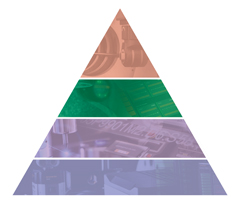工程内制御
right-first-time を実現するためのアクティブな制御。
工程内制御層では、加工作業中のフィードバックを通じて、工具の摩耗や温度変化といった加工中のばらつき要因に対する制御・調整に取り組みます。加工中にアクティブに対処する層です。
加工を自在にコントロール

工程内制御層では、加工作業中のフィードバックを通じて、工具の摩耗や温度変化といった加工中のばらつき要因に対する制御・調整に取り組みます。
加工中にアクティブに対処する層です。
インプロセス計測で実現できること
- 金属切削加工を、パーツの歪み、工具の振れや温度変化などが原因で起こる加工工程中のばらつきに合わせて適応
- 座標系、パラメータ、オフセット、論理プログラムフローを、実際のパーツ切削取り分に応じて更新
工具折損検出で確認できること
- 工具の有無
- 工具の位置 (工具抜けを確認)
- 工具折損、工具エッジの欠損
アクティブな制御
アクティブな制御を行うことで、試作なしでの生産が可能になり、やり直しや再加工の時間が不要になります。
自動工程内での計測により、オペレータの作業の間、機械を止める必要がありません。
サイクル内測定を行うことで、データに基づいて機械自身が判断を行い、長時間にわたる完全自動運転が可能になるため、生産能力を向上できます。
素材や環境の実際の状態に応じて加工作業を調整、順応させるうえで役に立つのがレニショーのワーク計測プローブ、TRS2 工具認識システム、Productivity+™ です。
資料
-
 カタログ: パンフレット: 生産効率を向上させるための計測ソリューション
カタログ: パンフレット: 生産効率を向上させるための計測ソリューション
プロセス制御のエキスパート企業が、貴社の生産工程のパフォーマンス変革をお手伝いします
